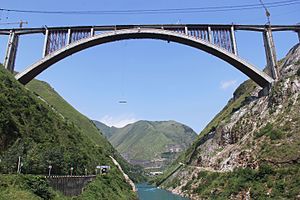Qinglong Railway Bridge
Coordinates: 25 ° 57 ′ 1 ″ N , 105 ° 15 ′ 18 ″ E
| Qinglong Railway Bridge | ||
|---|---|---|
| The bridge nearing completion | ||
| use | Railway bridge | |
| Crossing of | Beipan Jiang | |
| construction | Concrete - arch bridge | |
| overall length | 721 m | |
| Longest span | 445 m | |
| Arrow height | 100 m | |
| completion | 2016 | |
| location | ||
|
|
||
The Qinglong railway bridge is a concrete - arch bridge in the course of the section Guiyang - Kunming the Chinese high-speed line Shanghai Kunming that the deep valley of Beipan River with a span m of 445 at a height of 295 crosses m. It connects the railway tunnel on one side with the tunnel on the other. The section was opened in 2016.
The Qinglong Railway Bridge is part of the longest high-speed line in the world and is the largest concrete arch railway bridge in the world. It is one of the ten largest arch bridges and the twenty tallest bridges in the world.
It is not to be confused with the Beipanjiang Railway Bridge of the Shui-Bai Railway in Liupanshui.
location
It is located about 13 km northeast of Qinglong City in Guizhou Province . The 200 m high Guangzhao Dam is about 2 km upstream . 400 m downstream there is a road bridge built for construction. The Beipanjiang Bridge (Hukun Expressway) on the Shanghai – Kunming (G60) motorway , a suspension bridge crossing the river at a height of 318 m , is about 8.5 km as the crow flies downstream.
description
The high-speed route is only used for passenger traffic and is driven at up to 350 km / h.
The double-track, 721 m long railway bridge consists of a reinforced concrete arch with a CFST frame and a superstructure made of an elevated prestressed concrete - hollow box .
The arch rests on abutments concreted in the slopes , which are 25 m deep and extend up to 34 m into the rock.
The arch has a span of 445 m and an arrow height of 100 m. It has a rectangular, three-cell hollow cross-section with a constant height of 9.0 m. Its width of 18.0 m begins to increase from the outer 66 m of the arch and reaches 28.0 m at the abutments.
For its construction, two parallel CFST arches, each made of 4 tubes with a diameter of 75 cm, were created, which are connected to one another by half-timbered grids. The pipe bends were installed with the help of a cable crane , which was stretched across the valley on high scaffolding pillars high above the bridge. 40 prefabricated pipe segments of 12 m in length were joined together and braced to the 102 m high pillars that had already been built on the abutments and were provisionally raised by a framework. The finished pipe bends were then filled with concrete. After hardening, the arches were provided with formwork in sections based on the Melan construction method and set in concrete.
The two pillars above the abutments are 102.0 m high and, like all others, are designed as double pillars. The center distances to the next pillars are 65.9 m, which were bridged in cantilever construction from the two pillars. On the arch of the bridge there are 9 uprights at a center distance of 42.0 m each.
The superstructure consists of an 8.0 m wide single-cell prestressed concrete box girder, which protrudes 2.7 m on both sides to the 13.4 m wide deck. Its height of 7.5 m on the two pillars above the abutments decreases to 4.0 m in the middle of the neighboring fields and then remains unchanged. The fields above the arch were built individually with formwork that was conventionally supported on the arch and then connected.
Web links
- Beipanjiang Railway Bridge Qinglong on HighestBridges.com
- Beipanjiang Highspeed Railway Bridge Animation on YouTube (Chinese)
Individual evidence
- ↑ The information in this article is based, unless otherwise stated, on Beipanjiang Railway Bridge Qinglong on HighestBridges.com
- ↑ Longest high-speed route in the world opened. In: SZ-Online. December 27, 2012, accessed March 17, 2018 .
- ↑ Shanghai-Kunming line section starts operation on China.org.cn
- ↑ Scheme of the CFST arches on HighestBridges.com
- ↑ Elevation of the bridge on HighestBridges.com

